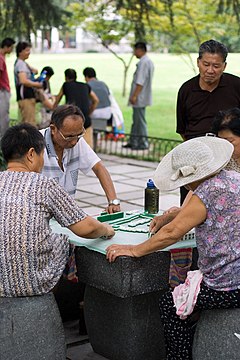
Back ما جونغ Arabic Madjonq Azerbaijani Маа Джонг Bulgarian মাহ্ জঙ Bengali/Bangla མ་ཅང་། Tibetan Mahjong Catalan Mà-chiók CDO Madžong Czech Mahjong Danish Mah-Jongg German
 Mahjong players in Hangzhou in 2006 | |
| Genres | |
|---|---|
| Players | 3 or 4 |
| Setup time | 1–5 minutes |
| Playing time | Dependent on variation or rules |
| Chance | Moderate |
| Skills | Tactics, observation, memory, adaptive strategies |
| Mahjong | |||||||||||||||||||||||||||||||
|---|---|---|---|---|---|---|---|---|---|---|---|---|---|---|---|---|---|---|---|---|---|---|---|---|---|---|---|---|---|---|---|
 "Mahjong" in Traditional (top) and Simplified (bottom) Chinese characters | |||||||||||||||||||||||||||||||
| Chinese name | |||||||||||||||||||||||||||||||
| Traditional Chinese | 麻將 | ||||||||||||||||||||||||||||||
| Simplified Chinese | 麻将 | ||||||||||||||||||||||||||||||
| |||||||||||||||||||||||||||||||
| Original/Southern Name | |||||||||||||||||||||||||||||||
| Traditional Chinese | 麻雀 | ||||||||||||||||||||||||||||||
| Simplified Chinese | 麻雀 | ||||||||||||||||||||||||||||||
| Literal meaning | little sparrows | ||||||||||||||||||||||||||||||
| |||||||||||||||||||||||||||||||
| Vietnamese name | |||||||||||||||||||||||||||||||
| Vietnamese | mạt chược | ||||||||||||||||||||||||||||||
| Thai name | |||||||||||||||||||||||||||||||
| Thai | ไพ่นกกระจอก | ||||||||||||||||||||||||||||||
| RTGS | phai nok krachok | ||||||||||||||||||||||||||||||
| Korean name | |||||||||||||||||||||||||||||||
| Hangul | 마작 | ||||||||||||||||||||||||||||||
| Hanja | 麻雀 | ||||||||||||||||||||||||||||||
| |||||||||||||||||||||||||||||||
| Japanese name | |||||||||||||||||||||||||||||||
| Kanji | 麻雀 | ||||||||||||||||||||||||||||||
| Kana | マージャン | ||||||||||||||||||||||||||||||
| |||||||||||||||||||||||||||||||
| Khmer name | |||||||||||||||||||||||||||||||
| Khmer | ម៉ាចុង | ||||||||||||||||||||||||||||||
Mahjong or mah-jongg[1] (English pronunciation: /mɑːˈdʒɒŋ/ mah-JONG) is a tile-based game that was developed in the 19th century in China and has spread throughout the world since the early 20th century. It is played by four players (with some three-player variations found in parts of China, Japan, South Korea, Vietnam, and Southeast Asia). The game and its regional variants are widely played throughout East and Southeast Asia and have also become popular in Western countries. The game has also been adapted into a widespread online entertainment.[2][3][4][5] Similar to the Western card game rummy, mahjong is a game of skill, strategy, and luck. To distinguish it from mahjong solitaire, it is sometimes referred to as mahjong rummy.
The game is played with a set of 144 tiles based on Chinese characters and symbols, although many regional variations may omit some tiles or add unique ones. In most variations, each player begins by receiving 13 tiles. In turn, players draw and discard tiles until they complete a legal hand using the 14th drawn tile to form four melds (or sets) and a pair (eye). A player can also win with a small class of special hands. While many variations of mahjong exist, most variations have some basic rules in common including how a piece is drawn and discarded, the use of suits (numbered tiles) and honors (winds and dragons), the basic kinds of melds allowed, how to deal the tiles and the order of play. Beyond these basic common rules, numerous regional variations exist which may have notably different criteria for legal melds and winning hands, radically different scoring systems and even elaborate extra rules. A group of players may introduce their own house rules which can notably change the feel of play.
- ^ "Mah-jongg". Merriam-Webster.com Dictionary. Merriam-Webster. Retrieved 19 January 2020.
- ^ "Mahjong Around the World". World Series of Mahjong. Archived from the original on 16 June 2018. Retrieved 25 January 2018.
- ^ Vickroy, Donna. "Growing interest in ancient Chinese game". Daily Southtown.
- ^ Glasser, AJ (20 July 2011). "Mad Respect for Mahjong on This Week's List of Fastest-Growing Games by DAU". Adweek.
- ^ "WITH VIDEO: 'Mahjong!' Ancient game enjoys continued popularity". The Courier. Archived from the original on 24 July 2018.